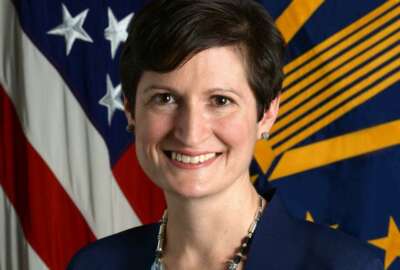
Meet the man who’s spent decades photographing the affairs of one large cabinet department
Since 1990, Chris Smith has been photographing the doings of the Health and Human Services Department. That's six administrations and nine secretaries. Now he's put...
Since 1990, Chris Smith has been photographing the doings of the Health and Human Services Department. That’s six administrations and nine secretaries. Now he’s put the lens cap on that career. The Federal Drive with Tom Temin took a historic stroll down memory with Chris Smith. Temin & Smith were both in studio.
Interview transcript:
Tom Temin And I have to tell people, I was looking forward to this interview, because in my own personal history, there is a great deal of photography, but it’s kind of way in the past when we got our hands wet in the darkroom. That’s not so much the case anymore, is it?
Chris Smith No, not really. I miss those days, those were the the good old days of photography. Now we’ve gone on to digital faster and more efficient in some ways.
Tom Temin Now, you think about the White House having staff photographer, some of them quite prominent and famous. One of my professors, many years ago, had been a White House photographer. But you don’t realize, in general, that departments have a photography role. What was your actual job? What did they charge you with doing?
Chris Smith Well, all the departments have photographers assigned to the secretary. My position was to photograph primarily the secretary. So everything, just about everything involving his public events.
Tom Temin And there’s a lot of those, aren’t there?
Chris Smith Oh yeah, it was quite busy. And I did everything from official portraits to grip and grins to studio photography to product photography. I consider myself a jack of all trades and a master of a lot of them.
Tom Temin A grip and grin, by the way, for the audience is what?
Chris Smith Is when a secretary is meeting with an official or sometimes someone is not quite as prominent, but a handshake shot.
Tom Temin A handshake, smiling at the camera for the gripping hands and grinning at the camera. I know what it meant, I’ve done it quite a few. And the technology of photography has really changed a lot. I think people understand this, but for working photographers, at some point you have to make the decision, I’m going to leave behind the Ektachrome and the Kodachrome and the color film and move on to digital.
Chris Smith I remember back in the film days, the film days kind of for me in [Department of Health and Human Services (HHS)] stopped around ’90-’91, If I had to guess. And I remember I would photograph a press conference, go to my darkroom, develop the 35 millimeter film, make contact sheet, pick out an image. I had to then go to the other darkroom, the printing darkroom, and print 500 5X7 prints. Then I would produce those, take it to the press shop, and they would take those 500 5X7 prints and mail them out. And that was back in those days. Now it’s a lot faster.
Tom Temin Right. So did you develop color film or just black and white?
Chris Smith Both. But for the press conferences, it was primarily black and white film.
Tom Temin Got it. And what’s it like being around a secretary for 9-5 or whatever the day might be?
Chris Smith I wish 9-5. It’s an education. Learning a lot is getting a chance to know the secretaries. It’s good to know what they like, and more importantly, what they don’t like.
Tom Temin Yeah. Tell us some things maybe a secretary said, don’t do that or I don’t like that.
Chris Smith It’s mostly you don’t want to crowd their space. You don’t want to shoot too much. You really want to kind of be a fly on the wall, just be there and be available. And then when you chance know the secretary, you can kind of feel what their comfort level of is of being close to them or just taking pictures.
Tom Temin Right. So there must have been a process by which you had to get them to become comfortable with you. They might have known, hey, look, a photographer goes with this position just like a limousine driver, a suburban driver or whatever else, someone to hang up your coat when you come in. But photography is kind of intimate. You get close to the person or you get behind them when they’re facing out, and maybe shooting up at them or down at them. How did you get that comfort level with high level officials?
Chris Smith Well, one of the first things I really like to do is, when a secretary came to the department, is one of the first things I wanted to do is meet the secretary and get an introduction to the secretary so they knew who I was. From there the conversation ensued. And and after that, you kind of go into work and take some of that from their vibe what they’re looking for. And sometimes I would ask them, they would tell me, but it was mostly that first the initial introduction was the important part.
Tom Temin Now, we said at the top that you had started photographing HHS in 1990, but that’s not when your career started.
Chris Smith My first job in the federal government was at NIH, at the National Institute of Health. And I was a darkroom photographer, developing film, making prints, things like that. And I did that for about three years. My first shooting job in the federal government was at the Department of the Treasury under Nicholas Brady. And I was there for about, three years or thereabouts. And then I started at HHS in 1990.
Tom Temin All right. So the secretary at that time was.
Chris Smith A Nicholas Brady.
Tom Temin Nicholas Brady. And what was that like?
Chris Smith It was really, it was very cool working that close to the White House. And I don’t know if it was because of that or because it was dealing with a lot of money. It was very staid. It was very, very conservative, very staid.
Tom Temin And at some point, Donna Shalala (D-Ohio) came along and she might have been the first female, No, I guess she wasn’t, actually. Patricia Roberts Harris(D-Ill.) Back in ’79.
Chris Smith And that was before I started, the first secretary that I started working with was Secretary Sullivan (R-Ga.), and then it was Secretary Shalala.
Tom Temin What was Donna Shalala like?
Chris Smith Secretary Shalala was the longest serving secretary of HHS. I remember Secretary Shalala joking as she went to be the longest serving secretary of HHS. The joke was she was going to get the agents to fly her out to California on her last day. She was a workhorse. She was working all the time. I mean, all the secretaries do. But she was she was at it constantly.
Tom Temin And of course, they came and went with Republican and Democratic, then Republican and Democratic administrations. You don’t talk politics with them. Did you find them all to be pretty much the same to deal with, in terms of their bearing in the job, regardless of who had appointed them?
Chris Smith Pretty much. And you don’t talk politics on the job unless you lose your job. So no.
Tom Temin All right. And any particular time, that maybe, that you had to photograph something for purposes of fulfilling the job as official photographer, and yet it was a really tough situation?
Chris Smith Yes that will be on Capitol Hill. All the secretaries have to go on Capitol Hill. And it’s not a pleasant situation for anybody involved. So the secretaries are being stressed, all of them are being stressed at that point on Capitol Hill. And you have a lot, a ton of other photographers that are photographing them, some more aggressively than others. But I still have to be there in photographs the secretary. But I don’t want to add to that stress levels. That gets to be a little uncomfortable, you have to do that. You have to do your job, you have to perform.
Tom Temin And photography has gotten a little bit quieter in those mass situations, where they used to have motor drives and there was all this flashing and whirring. I think people still have that in mind as the noise of photography, but it’s much more silent now. Does that help?
Chris Smith It’s interesting. Yes, like you’re talking about the flashes because of the film sensitivity. The sensitivity of the sensors, we’ve gone from flashes to now digital, where we don’t need as much flash. And then with digital, we’ve gone to pretty much silent. But I wonder about that. Like with an event on an secretary, the president walks in, the first thing you hear are the cameras and now you’re hearing less of that and you hear the flashes of the cameras and all the other stuff. Now you’re hearing less shutters.
Tom Temin We’re speaking with Chris Smith, who just recently retired after more than 30 years as an official photographer, mostly with the Health and Human Services Department. And what about photographing secretaries with the president? That must have come up from time to time.
Chris Smith Oh yeah, I’ve done that, of course, with every secretary I’ve served. And it’s very cool going to the White House. I remember one of the White House visits was, I went over to the White House early in the Obama administration before the secretary was sworn in. So that was a little different, because HHS we’re still in the news. Even at that point, we didn’t have a secretary.
Tom Temin That would have been Kathleen Sebelius (D-Ohio).
Chris Smith That is correct. Secretary Sebelius.
Tom Temin And did the White House photography staff kind of elbow you aside? Or think you’re a bumpkin in of the departments?
Chris Smith That is a good question is definitely a pecking order. It’s the White House photographers first, obviously. And then you have the press photographers and there’s even a pecking order within the press, photographers league. Departmental photographers are sort of like stepchildren, but you kind of get to know people and talk to them and make your acquaintances and things like that and you fit in, you deal with it.
Tom Temin And what about photographing events or photographing situations? I’m thinking of another department, say Interior has a gigantic library of photography of the national parks and of forests and of the different locations people might be. What about HHS? Did you ever have to go out and shoot programs and situational, almost like photojournalism.
Chris Smith From time to time, yes. And I work closely with my colleagues at NIH. They had a wealth of photography, in terms of library. From time to time, I would go to different situations in health care settings, and it’s pretty rare.
Tom Temin Does the government provide gear?
Chris Smith HHS has been great. I’ve had a great boss, Michael Wilker, and he’s been really good at providing me good equipment.
Tom Temin And he’s part of the public affairs apparatus.
Chris Smith Yes. I’m in Assistant Secretary of Public Affairs.
Tom Temin And what about personal photography? Is that something you plan to pursue in retirement?
Chris Smith I will. In retirement, I’ll do a couple of different things for personal photography, and also still professional photography. I’m still planning on freelancing on the commercial level.
Tom Temin Right. So no weddings or bar mitzvahs.
Chris Smith On a commercial level, so no weddings, no bar mitzvahs, things like that. I’m going on back to the commercial roots.
Tom Temin Family?
Chris Smith Wife, I’ve been married to her for 38 years. Best years of my life. Courtney Salmon Smith Corriveau, who’s now living in San Diego with her husband. And we have a brand new grandson of five months, Nate Corriveau.
Tom Temin So the first thing you got to do is get out there and take some great baby pictures.
Chris Smith There you go.
Tom Temin And unrelated to your career, you have an interesting background, with respect to your dad and grandfather.
Chris Smith My dad, Theodore P. Smith, and my father-in-law, Edward James Talbot, were both Tuskegee Airmen. Documented original Tuskegee Airmen.
Tom Temin Wow. What did you learn from that? Or take away from that?
Chris Smith It was something that those guys talked about later on in life, and especially my dad talked about later in life. Also my father-in-law. Great heritage, great work ethic, great guys that overcame adversity and did well in their lives, work hard.
Tom Temin And when you went to the art and photography career choice and went to college to study that, your dad didn’t say, What about the Air Force?
Chris Smith No, he didn’t. At that point, he was a retired D.C. fireman. And I learned a lot from him. And he was an EMT for a little bit on the private side. But when I want to go into photography, actually, he was a amateur photographer.
Tom Temin But he liked running toward danger.
Chris Smith That’s why he was probably an amateur photographer to get through some of that stress.
Copyright © 2025 Federal News Network. All rights reserved. This website is not intended for users located within the European Economic Area.
Tom Temin is host of the Federal Drive and has been providing insight on federal technology and management issues for more than 30 years.
Follow @tteminWFED
Related Stories





